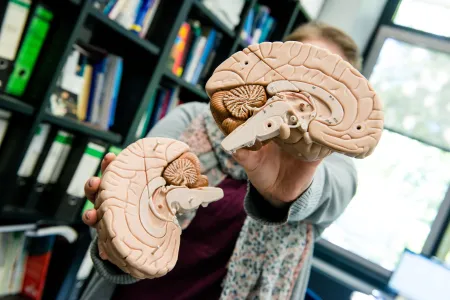Neuroscience
When pigeons dream
Birds show remarkably similar sleep patterns to humans and may experience flight in their dreams.
Dreams have been considered a hallmark of human sleep for a long time. Latest findings, however, suggest that when pigeons sleep, they might experience visions of flight. Researchers at Ruhr University Bochum, Germany, and at the Max Planck Institute for Biological Intelligence studied brain activation patterns in sleeping pigeons, using functional magnetic resonance imaging. The study revealed that similar to mammals, most of the brain is highly active during REM sleep. However, this wake-like state might come at a cost of reduced waste removal from the brain. The researchers published their findings in the journal Nature Communications on June, 5, 2023.
During sleep, our brain undergoes a complex set of processes to ensure we wake up feeling refreshed. In humans, the different phases of sleep, rapid eye movement (REM) and non-REM sleep, are associated with distinct changes in physiology, brain activity, and cognition. For instance, during REM sleep, our brain is very active and we experience our most vivid, bizarre, and emotional dreams. During non-REM sleep, the brain is metabolically less active and clears out waste products by flushing cerebral spinal fluid through the brain’s ventricles – the interconnected chambers that surround the structures of the brain – and then through the brain. This process supposedly helps the body to remove harmful protein deposits from the brain, like those associated with the development of Alzheimer's disease.
What happens in a pigeon’s brain during sleep?
The question of whether similar processes also take place in birds has remained unresolved until now. “The last common evolutionary ancestor of birds and mammals dates back about 315 million years, to the early days of land vertebrates,” says Professor Onur Güntürkün, head of the Biopsychology Department at Ruhr University Bochum. “Yet the sleep patterns in birds are remarkably similar to those in mammals, including both REM and non-REM phases.”
To find out what exactly happens when birds sleep, the researchers used infrared video cameras and functional magnetic resonance imaging (fMRI) to observe and record the sleeping and wakeful states of 15 pigeons specially trained to sleep under these experimental conditions.
The video recordings shed light on the sleep phases in the birds. “We were able to observe whether one or both eyes were open or closed, and to track eye movements and changes in pupil size through the pigeons’ transparent eyelids during sleep,” explains Mehdi Behroozi from the Bochum team. Simultaneously, the fMRI recordings provided information about brain activation and the flow of cerebral spinal fluid in the ventricles.
Dreams of flying
“During REM sleep, we observed strong activity in brain regions responsible for visual processing, including in those areas that analyze the movement of a pigeon’s surroundings during flight,” says Mehdi Behroozi. The team also noticed activity in the areas that process signals from the body, especially from the wings. “Based on these observations, we think that birds, just like humans, dream during REM sleep, and might be experiencing flight in their dreams,” adds Mehdi Behroozi.
Additionally, the scientists noticed activation of a particular brain area known as the amygdala during these phases. “This suggests that if birds experience something similar to our human dreams, pigeons’ dreams might include emotions as well,” says Gianina Ungurean from the Avian Sleep Group at the Max Planck Institute for Biological Intelligence. This hypothesis is supported by the fact that the birds’ pupils contract rapidly during REM sleep, like they do during courtship or aggressive behaviors while awake, as recently demonstrated by Gianina Ungurean and colleagues.
Washing out the day’s dust
Like in humans, the flow of cerebral spinal fluid through ventricles increases during non-REM sleep in pigeons. However, the team discovered for the first time, in any animal, that the flow diminished dramatically during REM sleep. “We think that the increased flood of blood into the brain during REM sleep, which supports the elevated brain activity, might block the cerebral spinal fluid from moving from the ventricles into the brain,” explains Niels Rattenborg, head of the Avian Sleep Group. “This suggests that REM sleep and its functions might come at the expense of waste removal from the brain.”
However, the scientists are also entertaining the possibility that REM sleep contributes to waste removal in unexpected ways. “At the onset of REM sleep, the influx of blood increases vessel diameter. This might force cerebral spinal fluid that entered the space during non-REM sleep to flow into the brain tissue, and enhance the outflow of fluids carrying waste products,” says Gianina Ungurean.
The researchers speculate that the process of cleaning the brain during sleep may be especially crucial for birds. Since their brains have a higher density of neurons in comparison to mammals, the removal of waste products may require more efficient – or more frequent – flushing cycles. As birds experience more and shorter REM phases during sleep than mammals, the associated frequent surge of blood might help to keep their densely packed brains free of harmful waste products.
Tell us about your dreams!
In the future, the team plans to explore REM sleep’s potential role in waste removal. In addition, they are thinking about ways to learn about the content of a pigeon’s dream. “We hope to train birds to report if and what they just saw upon awakened from REM sleep. That would be an essential step towards establishing whether they dream,” explains Gianina Ungurean. But even without a detailed dream analysis, the new findings already help us to better understand the role of sleep, in birds as well as in humans. They highlight the importance of sleep in maintaining a healthy brain and preventing cognitive decline – and they also imply that dreaming has a very long history.


